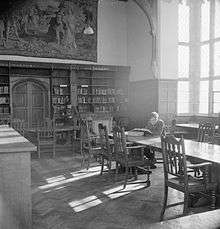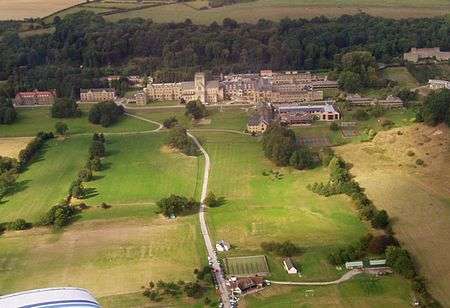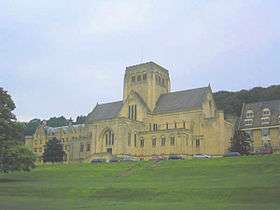Ampleforth College
Ampleforth College is a co-educational independent day and boarding school in the village of Ampleforth, North Yorkshire, England. It opened in 1802 as a boys' school, and is run by the Benedictine monks and lay staff[1]:1 of Ampleforth Abbey. The school is in a valley with sports pitches, wooded areas and lakes. Its affiliated preparatory school, St Martin's Ampleforth, is across the valley at Gilling Castle.
| Ampleforth College | |
|---|---|
 | |
| Location | |
| , , YO62 4ER England | |
| Coordinates | 54.201770°N 1.083910°W |
| Information | |
| Type | Public school Independent day and boarding |
| Motto | Dieu le ward (Anglo-Norman for God the protector) |
| Religious affiliation(s) | Roman Catholic (Benedictine) |
| Established | 1802 |
| Local authority | North Yorkshire |
| Department for Education URN | 121735 Tables |
| Chair | Cuthbert Madden |
| Headmaster | Robin Dyer |
| Gender | Co-educational |
| Age | 13 to 18 |
| Enrolment | 609~ |
| Colour(s) | Black and red |
| Former pupils | Old Amplefordians |
| Affiliated school | St Martin's Ampleforth |
| Diocese | Middlesbrough |
| Website | https://www.ampleforth.org.uk/college/ |
History

The college began as a small school for 70 boys founded by Benedictine monks, at Ampleforth Abbey, in 1802.[2] The school formally constituted as a Roman Catholic boarding school in 1900. Various buildings were slowly added, including the school theatre which was built in 1909. The first performances took place in 1910, and in 1922 a cinema projector was acquired, but could not be used until the following year when electric lighting and central heating were installed.[3]
The first boarding houses were founded in 1926 to accommodate the growing pupil numbers. In 1929, the Abbey gained ownership of Gilling Castle and opened a preparatory school. Gilling Castle Prep merged with the college's junior school in 1992 before taking on its current name St Martin's Ampleforth after absorbing another nearby prep school.
In 2002, girls were admitted for the first time when the sixth form became coeducational. The first girls' boarding house, St Margaret's, was opened in 2004.[4] Coeducation was extended to the Year 9 intake for the 2010–11 academic year and the college is now fully coeducational.[5]
Since the Catholic emancipation, Ampleforth gained a reputation as one of several schools, alongside The Oratory School and Stonyhurst, popular within the Roman Catholic aristocracy and labelled the "Catholic Eton".[6]
College tramway
In 1895, the North Eastern Railway built a 3 foot (0.91 m) gauge tramway from Gilling station on the Thirsk to Malton Line. The tram was horse-drawn, and provided coal for the college to produce gas. It also transported passengers in open wagons. The tramway closed in 1923 when the college changed to electric lighting.[7]
Education

The school says that its primary concern is to provide pupils with not just academic, sporting and other achievements, but also "a spiritual compass for life": moral principles to give guidance in a secular world;[8] within a context where the "Benedictine ethos permeates pupils' experience".[9]
The Good Schools Guide called the school an "Unfailingly civilised and understanding top co-educational boarding Catholic school that has suffered from time to time as a result of its long liberal tradition." The Guide adds also that there is "A refreshing openness and honesty about the place these days."[10]
Its academic admissions policy is not as exacting as that exercised by some other English public schools. The school is typically between 150 – 200 in the annual league tables of public examination results, although it was ranked 6th nationally in the 2004 "value added" table. It maintains a scholarship set, with about 5% of pupils gaining the offer of a place at Oxford or Cambridge.[11] More than 90% go on to university.
In 2018 the school failed an inspection by the Independent Schools Inspectorate regarding boarding provision, and the school was issued with a formal notice requiring the school to produce an Action Plan to resolve the failings. The Charity Commission had earlier removed pupil safeguarding responsibilities from the school's trustees, and the headmaster had been suspended from the Headmasters' and Headmistresses' Conference over safeguarding concerns.[12]
In July 2019 it was reported that the school's acting head was stepping down after 10 months in the job. The move followed an unannounced inspection to monitor progress, carried out in May, at the request of the Department for Education, which found the school did not meet standards for safeguarding, leadership, behaviour, combating bullying and complaints handling.[13] However, in Spring 2019 the school passed a compliance inspection under a new head[14]
School life
Though originally a boys' school the college is now fully co-educational. In 2009 an OFSTED Social Care report said that the overall quality of care was outstanding;[15] in 2013 it was deemed "excellent".[1]:9

Houses

The school is arranged into ten houses, with pupils living in separate house buildings, eating together as a house for lunch 6 days a week, and playing sport in inter-house competitions. Each house is named after a British saint. Boys houses are St Cuthbert's, St Dunstan's, St Edward-Wilfrid's (as of September 2018 became Junior House) which were originally two separate houses, St Hugh's, St John's, St Oswald's, and St Thomas's, and girls, St Aidan's, St Bede's and St Margaret's.
Some houses are paired into buildings named after people who have been instrumental in the school's history. Hume House building, named after Cardinal Basil Hume, combines St Cuthbert and St Edward-Wilfrid houses. Nevill House building combines St Dunstan and St Oswald houses. Bolton House building was formerly St Edward and St Wilfrid houses before their merger in 2001. Fairfax House building combines St Margaret and St Hugh houses.
Controversy
Fee-fixing
In September 2005, Ampleforth was one of fifty of the country's leading independent schools which were found by the Office of Fair Trading to be operating a fee-fixing cartel in breach of the Competition Act of 1998. All of the schools were ordered to abandon this practice, pay a nominal penalty of £10,000 each (with minor exceptions) and make ex-gratia payments totalling three million pounds into a trust designed to benefit pupils who attended the schools during the period in respect of which fee information was shared.[16][17] Mrs Jean Scott, the head of the Independent Schools Council, said that they were unaware that the law had changed, and that private schools had not known that they had become subject to competition law.[18]
Sexual abuse
Several monks and three members of the lay teaching staff molested children in their care over several decades. In 2005 Father Piers Grant-Ferris admitted 20 incidents of child abuse. This was not an isolated incident.[19] The Yorkshire Post reported in 2005: "Pupils at a leading Roman Catholic school suffered decades of abuse from at least six paedophiles following a decision by former Abbot Basil Hume [later a cardinal, and Archbishop of Westminster] not to call in police at the beginning of the scandal."[19] Following the case the Abbot, Cuthbert Madden, offered a "heartfelt apology" to the victims of one member of staff.[20]
The College thereafter put in place a safeguarding policy, subsequently judged inadequate (see below), but which was said to follow the local inter-agency procedures of the North Yorkshire Safeguarding Children Board and the guidance given in the Education (Independent School Standards) (England) Regulations 2010 and the National Minimum Standards for Boarding Schools.[21] In accordance with this policy, in 2016 Fr Madden temporarily stepped down from his role of Chairman of Governors during the investigation of indecent assault allegations made by four former pupils.[22] Based on the evidence available no further action was taken.[23]
In April 2018 the Charity Commission appointed a lawyer to take charge of safeguarding at Ampleforth College, as it was not satisfied that the trustees of the charities that run the college had made enough progress in improving pupil safeguarding. Harvey Grenville, leader of investigation and enforcement for the Charity Commission, said, "It is of paramount importance that beneficiaries, and others who come into contact with charities, are protected from harm. We are not satisfied that the trustees of these charities have made enough progress in improving the safeguarding environment for pupils in the schools connected to the charities. For this reason, we have appointed an interim manager to expedite changes in the safeguarding arrangements at the schools".[24]
The Independent Inquiry into Child Sexual Abuse (IICSA) investigated the English Benedictine Congregation, including Ampleforth College and Downside School, amongst other institutions, and published a report in August 2018.[25] Ten individuals from the two schools, including monks, were convicted or accepted a caution for abuse. The report said that appalling abuse was inflicted on pupils over 40 years, but the schools tried to cover up appalling allegations. The Chair of the Inquiry, Prof. Alexis Jay, said that the schools for decades tried to avoid giving any information to police or authorities, with monks being "secretive, evasive and suspicious of anyone outside the English Benedictine Congregation", prioritising "the reputation of the Church and the wellbeing of the abusive monks" over safeguarding. After new procedures were introduced in 2001 following the Nolan Report, which recommended that abuse should be referred to the statutory authorities, monks gave the appearance of co-operation and trust, but in reality continued to cover up the abuse.[26][27]
Notable Old Amplefordians
The school has educated many notable figures including Rupert Everett, David Stirling, Lord Fellowes of West Stafford, Lord Bamford, Sir Antony Gormley, James O'Brien, Timothy Oulton, actor James Norton, Rugby World Cup winner Lawrence Dallaglio, and historians William Dalrymple and John Keay.
St. Bede’s Preparatory School, Bishton Hall
Also Charles Stafford-Northcote, Headmaster of St. Bede's Preparatory School, Staffordshire (closed 2018) of which Lord Bamford was a former pupil and after: The University at Grenople. He donated the school's swimming pool roof with the proceeds of his inheritance from his father; Joseph Cyril Bamford (founder of the machinery company JCB). Also the Dukes of Norfolk (Earls of Arundel) went to Ampleforth with their family attending St. Bede's beforehand.[28][29]
References
- "AMPLEFORTH COLLEGE = Integrated Inspection" (PDF). INDEPENDENT SCHOOLS INSPECTORATE. 2013.
- "History of the Ampleforth Community". Archived from the original on 11 August 2011. Retrieved 13 May 2012.
- "Theatre – A brief history". Ampleforth College. Archived from the original on 19 April 2012. Retrieved 13 May 2012.
- "Girls' Houses – St Margaret's". Ampleforth College. Archived from the original on 14 November 2012. Retrieved 1 December 2012.
- "Ampleforth College to admit Year 10 girls". York Press. 23 December 2009. Archived from the original on 6 August 2013. Retrieved 1 December 2012.
- "Have posh Catholics had their day?". The Catholic Herald. 2 July 2015. Archived from the original on 24 January 2016. Retrieved 4 February 2016.
- "Gilling Railway Station". Disused Stations. Retrieved 7 November 2015.
- "An Introduction from the Headmaster". Ampleforth College. Archived from the original on 2 May 2008. Retrieved 15 February 2011.
- "School Development Plan Explored Further". Ampleforth College. Archived from the original on 14 June 2009. Retrieved 15 February 2011.
- "Ampleforth College, York". The Good School Guide. Archived from the original on 18 February 2011. Retrieved 15 February 2011.
- "School Development Plan 2006–2007". Ampleforth College. Archived from the original on 1 March 2008. Retrieved 18 February 2008.
- Gledhill, Ruth (30 July 2018). "Ampleforth faces possible closure if it fails to improve standards". The Tablet. Retrieved 9 August 2018.
- correspondent, Harriet Sherwood Religion (3 July 2019). "Head of top Catholic school stands down after damning report". The Guardian. ISSN 0261-3077. Retrieved 3 July 2019.
- School passed inspection yet
- "Ampleforth College Inspection report for boarding school" (PDF). Ofsted. 23 January 2009. Retrieved 18 October 2016.
- "OFT names further trustees as part of the independent schools settlement". The Office of Fair Trading. Archived from the original on 2 April 2014. Retrieved 23 May 2008.
- Halpin, Tony (10 November 2005). "Independent schools face huge fines over cartel to fix fees". The Times. London. Archived from the original on 12 September 2012. Retrieved 23 May 2008.
- "Private schools send papers to fee-fixing inquiry". The Daily Telegraph. London. 1 March 2004. Retrieved 15 March 2011.
- "Ampleforth child abuse scandal hushed up by Basil Hume". The Yorkshire Post. 18 November 2005. Retrieved 22 December 2007.
- Cobain, Ian (18 November 2005). "Silence and secrecy at school where child sex abuse went on for decades". The Guardian. Retrieved 15 November 2016.
- "Ampleforth Abbey & College". Retrieved 24 March 2017.
- "Ampleforth College abbot steps aside as police probe historical abuse claims". The Yorkshire Post. 1 September 2016. Retrieved 15 November 2016.
- "Ampleforth College: 'No action' over abuse allegation". BBC News. 4 November 2016. Retrieved 4 April 2018.
- Harriet Sherwood (4 April 2018). "Top Catholic school stripped of pupil welfare responsibilities". The Guardian. Retrieved 4 April 2018.
- Ampleforth and Downside (English Benedictine Congregation case study) – Investigation Report (PDF) (Report). Independent Inquiry into Child Sexual Abuse. 9 August 2018. Retrieved 9 August 2018.
- "Child abuse inquiry: School 'reputations put before abuse victims'". BBC News. 9 August 2018. Retrieved 9 August 2018.
- Harriet Sherwood and Rob Evans (9 August 2018). "Report damns culture of acceptance of sexual abuse at two Catholic schools". The Guardian. Retrieved 9 August 2018.
- Sweney, Mark (1 February 2016). "James Norton: TV producers also typecast against posh actors". The Guardian. Retrieved 5 July 2017.
- "Ampleforth". Retrieved 24 March 2017.
External links
| Wikimedia Commons has media related to Ampleforth College. |
- Ampleforth College official site www.ampleforth.org.uk/college
- Profile at the Independent Schools Council website
- Profile at The Good Schools Guide
- OAs Online – alumni website